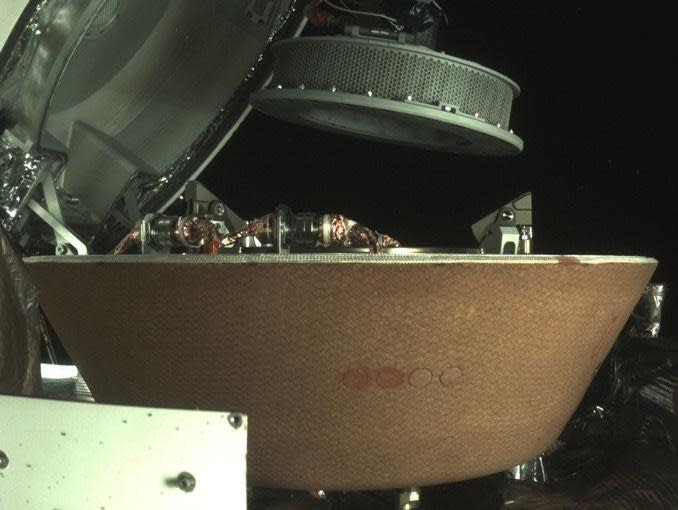Asteroid samples sealed up for return to Earth

An estimated two pounds or more of rock and soil collected from the asteroid Bennu by NASA's OSIRIS-REx spacecraft have been successfully sealed up in a protective re-entry capsule for return to Earth in 2023, project managers said Thursday.
While detailed hands-on analysis cannot begin until the samples are returned, scientists have already gained insights into the flaky nature of Bennu's soil, or regolith, by watching how it behaved when the rocks and soil were collected on October 20.
And that is already feeding into discussions about how to possibly one day divert a threatening asteroid from a collision with Earth.
"The OSIRIS-REx mission has collected a phenomenal data set about asteroid Bennu, which is a potentially hazardous asteroid with approximately (a) 1-in-2,700 chance of impacting the Earth late in the 22nd century," said Dante Lauretta, the mission's principal investigator.
"The biggest uncertainties on the mission where the response of the regolith to the TAGSAM (sample collector) pressing down onto the surface. And I know already different groups within NASA and other agencies have been able to use our data set for scenarios of the kind that you're describing."

Said Lori Glaze, director of planetary science at NASA Headquarters: "I think this information is going to be incredibly important as we think about how to mitigate future potential impacts from these potentially hazardous objects."
But the primary goal of the OSIRIS-REx mission was to collect a minimum of 60 grams — 1.1 ounces — of rock and soil from Bennu, and the spacecraft appears to have far exceeded that modest requirement.
During a dramatic touch-and-go impact October 20, the spacecraft slowly descended to the surface of Bennu, pressing its TAGSAM collector down onto the soil as compressed nitrogen gas was released, stirring up a blizzard of rocks and fine-grained particles.
The collector was designed so the gas would drive small particles into internal chambers, capturing them for return to Earth. In fact, the TAGSAM captured so much material a flap intended to seal the material inside the collector was jammed open by a rock fragment, allowing small fragments to escape.
As a result, mission managers opted to stow the collector well ahead of schedule, foregoing plans to "weigh" the collected samples by slowly spinning the spacecraft and carefully analyzing its motion compared to earlier measurements when the sample collector was empty.
But with soil and small rock fragments working their way out of the collector, time was of the essence. Earlier this week, flight controllers carried out a 36-hour procedure to reposition OSIRIS-REx's robot arm so the TAGSAM collector on the far end could be stowed and sealed inside a protective capsule.
If all goes well, OSIRIS-REx will begin the two-year trip back to Earth next spring. The sample capsule will be released in September 2023 for a parachute descent to Utah where recovery crews will be waiting to rush the material to a lab at the Johnson Space Center for initial analysis.
Because mission managers decided not to attempt weighing the collected samples, they do not know for sure how much material was captured. But based on the amount visible to OSIRIS-REx's cameras, Lauretta said he is confident at last two pounds or rock and soil were scooped up as the TAGSAM pressed into and blow Bennu's surface.
"There was very little resistance to the spacecraft's downward motion from the asteroid regolith," he said. "And so we were continuing to penetrate and burrow underneath the subsurface of the asteroid while the TAGSAM gas was being injected into the regolith.
"Current assessments are that we penetrated a minimum of 24 centimeters (9.4 inches) ... and possibly as deep as over 48 centimeters (18.9 inches) with TAGSAM gas firing and collecting and driving material into the collection chamber during that entire time. So we are highly confident ... the TAGSAM was was full to capacity."
Even though a few "tens of grams" of material managed to float free of the sample collector before it could be stowed, Lauretta said he believes "we still have hundreds of grams of material in the sample collector head, probably over a kilogram easily."
"But of course, we have to wait till 2023 to open up the TAGSAM and be sure."
Two American students convicted of killing an Italian police officer
Emmanuel Acho wants kids to have a "true dialogue" on race
Hungary's Prime Minister Orban tightens grip with university legislation

